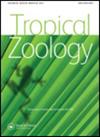委内瑞拉硬脂虫科的新种和记录(甲壳纲、等足目、洋葱目)
IF 0.4
4区 生物学
Q4 ZOOLOGY
引用次数: 0
摘要
硬脂虫科有八种记录自委内瑞拉。三个物种被描述为新物种:Aragua和Miranda省的委内瑞拉Colomboscia n.sp.,Trujillo省的cristalinae Glopopectes n.sp.和梅里达省的mucuyensis Glopopects n.sp。番木瓜和委内瑞拉新三倍子的分布范围分别扩大到阿拉瓜省和卡拉波波省。本文章由计算机程序翻译,如有差异,请以英文原文为准。
New species and records of the family Scleropactidae Verhoeff, 1938 from Venezuela (Crustacea, Isopoda, Oniscidea)
Eight species in the family Scleropactidae are recorded from Venezuela. Three species are described as new: Colomboscia venezuelana n. sp. from the departments of Aragua and Miranda, Globopactes cristalinae n. sp. from the department of Trujillo, and Globopactes mucuyensis n. sp. from the department of Mérida. Globopactes senex and Neosanfilippia venezuelana have their distribution extended to the departments of Aragua and Carabobo, respectively.
求助全文
通过发布文献求助,成功后即可免费获取论文全文。
去求助
来源期刊

Tropical Zoology
生物-动物学
CiteScore
2.50
自引率
0.00%
发文量
1
审稿时长
>12 weeks
期刊介绍:
Tropical Zoology is an international zoological journal publishing original papers in the field of systematics, biogeography, phylogeny, ecology and conservation of all terrestrial and aquatic animal Phyla from tropical and subtropical areas.
Only papers with new information, high quality and broad interest are considered. Single species description and checklists are not normally accepted. Review papers are welcome. The journal is owned by the Istituto di Ricerca sugli Ecosistemi Terrestri of the Consiglio Nazionale delle Ricerche, Florence, Italy (CNR-IRET) who performs research into the structure and functioning of aquatic and terrestrial ecosystems, focusing in particular on anthropogenic pressure and global change. The knowledge amassed forms the scientific basis for identifying the most appropriate protective and corrective interventions, and provides support for the bodies entrusted with formulating policies for environmental protection and recovery.
 求助内容:
求助内容: 应助结果提醒方式:
应助结果提醒方式:


